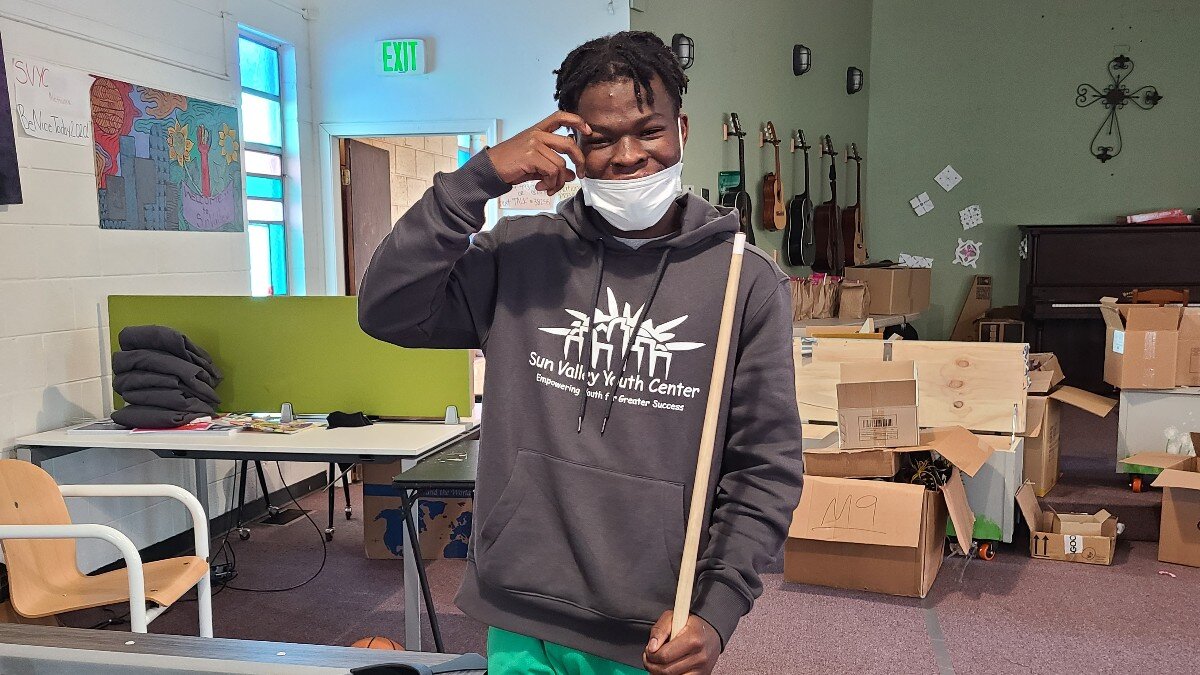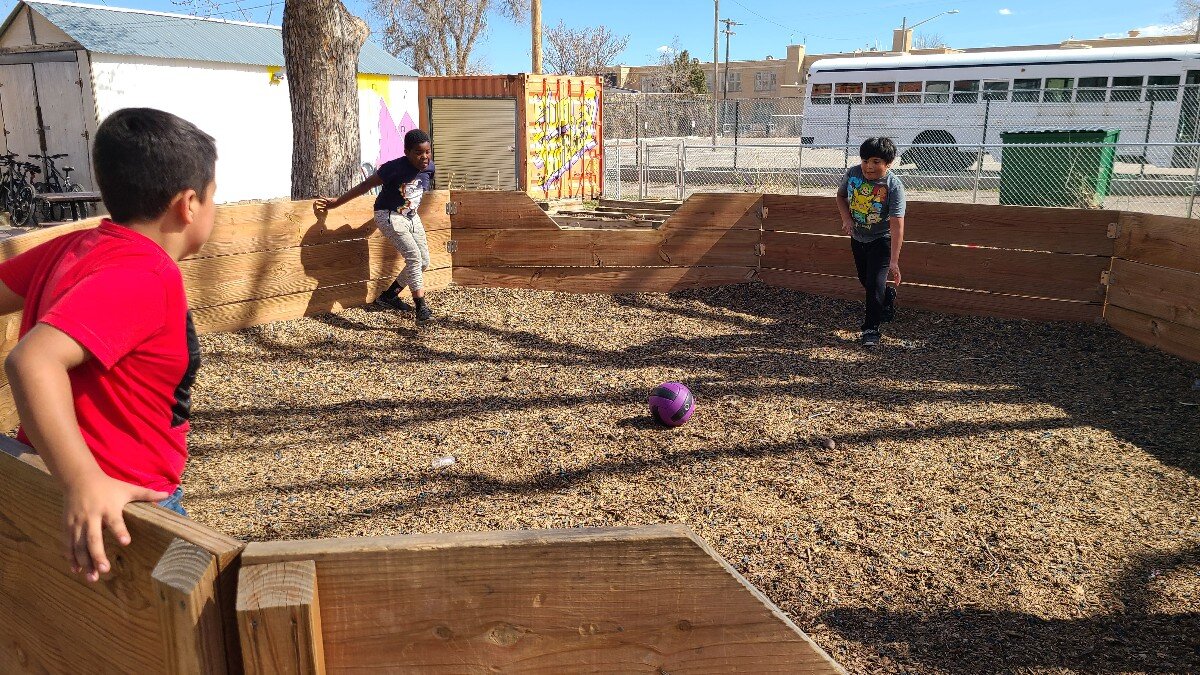In Denver's Sun Valley neighborhood, a community center supports youth during unprecedented change

DENVER — Kris Rollerson believes that the positive things about Sun Valley, Denver’s poorest neighborhood, are often ignored for the bad.
“I sometimes feel like we're so cut off from everything that we do our own thing over here and like not to be bothered, but I think, the rest of Denver needs to know that this community is here, that it exists, that it's thriving, and the kids are here,” said Rollerson, the executive director of the Sun Valley Youth Center.
Since the center was developed in 1999 by community members and a local church, the center has served hundreds of urban youths every year with after-school programs for kids of all ages.
The center’s elementary space includes boxes of supplies and sensory toys for the children: There are noise canceling headphones that kids can use when they need a break. Wheels on the wall with different colors and labels help kids vocalize their feelings. A mindfulness bell helps them learn what it feels like to be completely quiet. Kids can hit a cushioned spot by the door when they are feeling frustrated.
Upstairs in the middle and high school space, older kids can play games like pool or chess. There are chairs to sit, chat, and relax.
Kids can participate in classes ranging in a variety of topics, like cooking, healthy life sciences, and martial arts. They can also get help with homework and regularly go on field trips around Colorado. Sometimes the staff, particularly staff members that were previously youths in the program, will buy the kids ice-cream after their trips.
Rollerson said that staff and volunteers are trained to use the trust based-relational intervention model for guiding care.
“It’s basically attachment theory,” she explained. “It’s giving the kids safe places to have and feel big emotions.”
Rollerson added that what might look like simple play can really be opportunities to teach kids how to self-regulate emotions. Sometimes, kids will walk through re-enactment plays with staff to turn conflicts into teachable moments and opportunities for compromise.
“If we just kick them out or send them home, they don't actually learn how to do that on their own, which makes them more likely to storm off of a job or to drop out of school,” Rollerson said. “Our kids have a lot of trauma all the time, and a lot of times they're just in that constant state of trauma. It’s about teaching them and helping them learn what it is to be calm and also what it is to learn and play.”

When the pandemic first started, Rollerson worried how families in the community would be affected.
“I literally was having panic attacks that every single, single mom was going to get COVID and die, and we were going to have 800 orphans,” she said.
So Rollerson went out and found lawyers to help parents draft wills that would stand up in the court of law, just in case. Meanwhile, community rallied together and tried to preserve everyone’s safety for a long time by staying inside and social distancing.
She and the staff realized that they needed to reach out to parents in the neighborhood and ask them what they needed for support. In the past, Rollerson said, they would engage with parents by walking through neighborhoods, knocking on doors and talking to people one-on-one. When the pandemic started, they began regularly calling parents and checking-in. If there was a need vocalized by kids or parents, the staff did what they could to meet it.
Many parents had one main request: they asked for their kids to take part in the center’s programs in-person again.
“One mom just wanted us to, like, grab her kid and take them for a walk, you know, just so that she could have an hour because she had no support, like no family here, no nothing,” Rollerson said. “So just in her and her kiddo in the house for like four or five months. No separation. No break.”
Rollerson believes the feedback they received is a testament to the amount of trust the Sun Valley Youth Center has cultivated with families in the community through years of hard work and continuous communication.
“I've been here 23 years, so the new community doesn't know me from anybody, but historically, I just faithfully show up,” Rollerson said. “And because I faithfully show up, everybody faithfully shows up … we have very little turnover.”
In 2019, the Denver Housing Authority (DHA) began implementing the Sun Valley Neighborhood Transformation Plan, which aims to replace 333 public housing units with newly constructed developments throughout the neighborhood. Families in the neighborhood were notified that they would need to relocate as their homes were being torn down.
According to 5280, the DHA gave families the choice to move back into the new buildings once they were completed, move to other DHA public housing options, apply for a housing choice voucher, or receive a check so that they could relocate to another neighborhood on their own.
Denisee Sierra, the middle and high school director, reported that few families returned. Still, Sierra noted that many kids that moved to areas like Aurora or Green Valley Ranch stayed in the after-school program. Some commute for more than an hour to the center.
According to Sierra, her favorite thing to do at the center is to talk with the kids.
“I think that’s when you could be real with them and then connect with them on a different level where they start trusting you,” Sierra said. “And I think once they have trust, we’re able to navigate everything else, and that’s how we get them to do programs.”

It is because of Sierra, 15-year-old Bery Belitra said, that he now wants to be a heart surgeon.
While Belitra no longer lives in the Sun Valley neighborhood, he continues to visit the center and has been in the program since he was about five years old.
“This place is amazing. You won’t find it anywhere else in Colorado,” Belitra said. “If you come here, there’s nothing you can’t do. It’s too much fun.”
Belitra is in 10th grade. He loves learning in school, and his favorite subject is math. He said that he wanted to be a doctor the moment Sierra showed a heart diagram in a class at the center.
“She was giving all these examples about how many times lives were saved. And I was like, ‘Dang. I could do that,’” Belitra said.

22-year-old Diamond Sykes started coming to the center when she was nine. Sykes and her sister D’naeya, who was also a previous youth and is now a middle and high school group leader, know firsthand how impactful the center’s programs can be.
When she thought about her own experiences as a child in the program, Sykes said, “I don't know that I would have ever gone camping and stuff on my own if I didn't learn the skills I have here. My mom didn't really take us, because she doesn't really know how to like camp or anything … There's so many places we visited. I was like, ‘I've been here my whole life. How did I not know that this is here?’ So, I don't know. I'm just super grateful that I had that opportunity and generations behind me continue to have that opportunity as well.”
Today, she is the Sun Valley Youth Center’s elementary director.
“It's just nice to be able to give back and do for other kids what Kris did for me and just be a very consistent role model in their lives to push them and let them know that they do have a bright future,” Sykes said.
She also mentioned that one of the stories she likes to tell people is about a time when she and some of the little kids went to the Plains Museum. Because of that trip, one of the youths now dreams about being a pilot.
“I feel like when people are in poverty, they feel stuck in a box. And it's hard for the kids to, like, branch out and dream big sometimes,” Sykes said. “There's so much out there, and just allowing them through field trips and stuff to even explore those passions and interests and see what else is out there – that’s what I like.”

While the pandemic has been hard in many ways, Kris Rollerson believes that it has also brought more resources into the community than it had before.
All around the center, the Sun Valley neighborhood shows signs of change – new housing developments are beginning to replace the red-brick public housing units. Sun Valley, a well-known food desert, now has a grocery store that opened just last year with affordable, multicultural food and free deli items for kids under 18.
“Now, all of a sudden, everyone delivers,” Rollerson said. “We used to not be able to get, like, pizza delivered here. Now you can get almost everything delivered anywhere from downtown, right? Like restaurants that some of our families maybe never would have tried, ever.”
According to Rollerson, the center will also be changing soon. In the next three years, the Sun Valley Youth Center will start a capital campaign to build a new building. Rollerson hopes to create a space that’s designed for the youth coming into – or coming back into – the community.
Before redevelopment started, Rollerson explained, the center had around 800 kids enrolled in the program and a continuous waiting list. Looking towards the future, Rollerson hopes that the center will continue to grow.
Theresa Ho is the RMPBS Kids digital content producer. You can reach her at theresaho@rmpbs.org.
